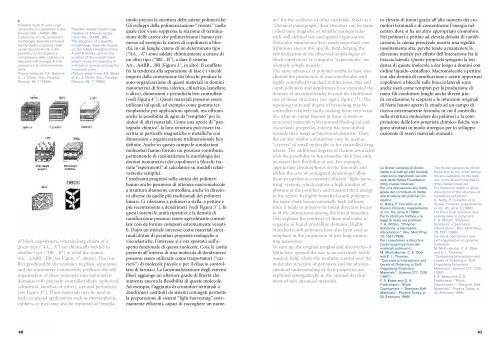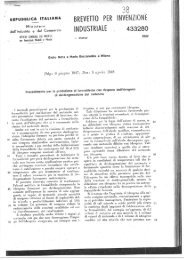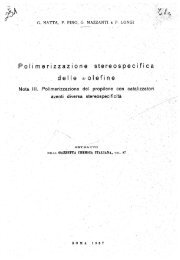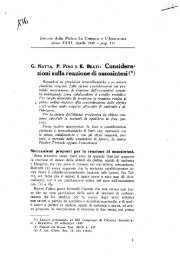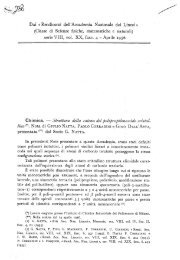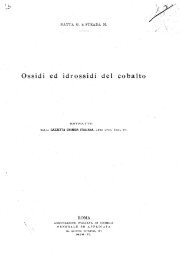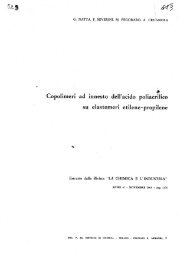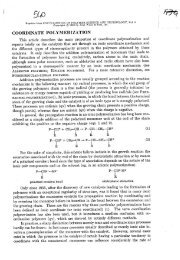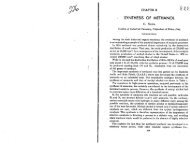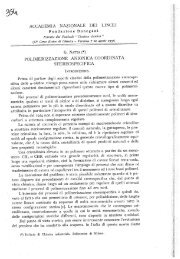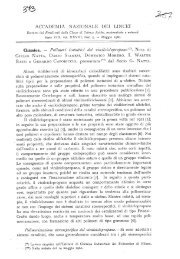n. 7, Ottobre 2003 - Giulio Natta
n. 7, Ottobre 2003 - Giulio Natta
n. 7, Ottobre 2003 - Giulio Natta
Create successful ePaper yourself
Turn your PDF publications into a flip-book with our unique Google optimized e-Paper software.
4.<br />
Possibili modi di auto-organizzazione<br />
di copolimeri a due<br />
blocchi (AA…AABB...BB).<br />
L’adozione di una particolare<br />
morfologia dipende principalmente<br />
dalla lunghezza relativa<br />
dei blocchi A e B, e dal<br />
prodotto tra la lunghezza<br />
complessiva delle catene e la<br />
disparità nell’energia di interazione<br />
tra le unità monomeriche.<br />
[Figura tratta da: F.S. Bates et<br />
al., J. Chem. Soc., Faraday<br />
Discuss. 98, 7 (1994)].<br />
Possible modes of self-organization<br />
of diblock copolymers<br />
(AA…AABB...BB).<br />
The adoption of a specific<br />
morphology depends mainly<br />
on the relative lengths of the<br />
A and B blocks, and on the<br />
product of the overall chain<br />
length times the disparity in<br />
interaction energy among the<br />
monomer units.<br />
[Picture taken from: F.S. Bates<br />
et al., J. Chem. Soc., Faraday<br />
Discuss. 98, 7 (1994)].<br />
modo preciso la struttura delle catene polimeriche.<br />
Gli sviluppi della polimerizzazione “vivente” (nella<br />
quale cioè viene soppressa la reazione di terminazione<br />
delle catene che polimerizzano) hanno permesso<br />
ad esempio la sintesi di copolimeri a blocchi,<br />
in cui lunghe catene di un determinato tipo<br />
(“AA…A”) sono saldate chimicamente a catene di<br />
un altro tipo (“BB…B”), a dare il sistema<br />
AA…AABB…BB [Figura 3 , in alto]. Il conflitto<br />
fra la tendenza alla separazione di fase e i vincoli<br />
imposti dalla connessione dei blocchi produce la<br />
auto-organizzazione di questi materiali in domini<br />
nanometrici di forma (sferica, cilindrica, lamellare,<br />
o altro), dimensioni e periodicità ben controllate<br />
[vedi Figura 4 ]. Questi materiali possono essere<br />
utilizzati tal quali, ad esempio come gomme termoplastiche<br />
per applicazioni speciali, ma offrono<br />
anche la possibilità di agire da “templato” per la<br />
sintesi di altri materiali. Come una specie di “pantografo<br />
chimico”, la loro struttura può essere trascritta<br />
in particelle magnetiche o metalliche con<br />
dimensioni e organizzazione tridimensionale ben<br />
definite. Anche in questo campo le simulazioni<br />
molecolari hanno fornito un prezioso contributo,<br />
permettendo di razionalizzare la morfologia dei<br />
domini nanometrici dei copolimeri a blocchi tramite<br />
“esperimenti” al calcolatore su modelli relativamente<br />
semplici.<br />
I medesimi progressi nella sintesi dei polimeri<br />
hanno anche permesso di ottenere macromolecole<br />
a struttura altamente controllata, anche in direzioni<br />
diverse da quelle più tradizionali dei polimeri<br />
lineari. Ci riferiamo a polimeri a stella, a pettine e<br />
più recentemente a dendrimeri [vedi Figura 3 ]. In<br />
questi sistemi le unità ripetitive e la densità di<br />
ramificazione possono essere agevolmente controllate<br />
così da fornire composti estremamente versatili.<br />
Dopo un iniziale interesse come materiali strutturali<br />
dotati di peculiari proprietà reologiche o<br />
viscoelastiche, l’interesse si è ora spostato sull’aspetto<br />
funzionale di queste molecole. Così, le cavità<br />
presenti all’interno di una molecola di dendrimero<br />
possono essere utilizzate come trasportatori (“carriers”)<br />
di molecole piccole o per il rilascio controllato<br />
di farmaci. La funzionalizzazione degli estremi<br />
liberi aggiunge un ulteriore grado di libertà che<br />
aumenta ancora la flessibilità di queste molecole.<br />
Ad esempio, l’aggiunta di cromofori terminali a<br />
dendrimeri costituiti da sistemi coniugati permette<br />
la preparazione di sistemi “light-harvesting” estremamente<br />
efficienti, capaci di raccogliere un numeof<br />
block copolymers, wherein long chains of a<br />
given type (“AA…A”) are chemically welded to<br />
another type (“BB…B”) to yield the system<br />
AA…AABB…BB [see Figure 3 , above]. The conflict<br />
produced by the tendency to phase separation<br />
and the monomers’ connectivity produces the selforganization<br />
of these polymers into nanometric<br />
domains with precisely-controlled shape (spherical,<br />
cylindrical, lamellar, or other), size and periodicity<br />
[see Figure 4 ]. These materials may be used as<br />
such, in special applications such as thermoplastic<br />
rubbers, or they may also be exploited as “templa-<br />
tes” for the synthesis of other materials. Much as a<br />
“chemical pantograph”, their structure can be transcribed<br />
onto magnetic or metallic nanoparticles<br />
with well-defined size and spatial organization.<br />
Molecular simulations have made important contributions<br />
also in this specific field, helping the<br />
rationalization of the observed mophologies of<br />
block copolymers by computer “experiments” on<br />
relatively simple models.<br />
The same advances in polymer synthesis have also<br />
allowed the production of macromolecules with<br />
highly controlled branched architectures. Star and<br />
comb polymers and dendrimers have expanded the<br />
domain of macromolecules beyond the traditional<br />
one of linear structures [see again Figure 3 ]. The<br />
repeating units and degree of branching may be<br />
controlled relatively easily, making them very versatile.<br />
After an initial interest in these systems as<br />
structural materials with unusual rheological and<br />
viscoelastic properties, interest has now shifted<br />
towards their usage as functional elements. Thus,<br />
the cavities within a dendrimer may be used as<br />
“carriers” of small molecules or for controlled drug<br />
release. The additional degrees of fredom associated<br />
with the possibility to functionalize their free ends<br />
increases their flexibility of use. For example,<br />
appropriate chromophores on the free ends and<br />
within the core of conjugated dendrimers allow<br />
them to operate as extremely efficient “light-harvesting”<br />
systems, which capture a high number of<br />
photons at the periphery and transmit their energy<br />
to the centre. In highly branched comb polymers,<br />
the main chain has an unusually high stiffness,<br />
since it tends to preserve its initial direction because<br />
of the interactions among the lateral branches.<br />
This explains the tendency of these molecules to<br />
organize in liquid-crystalline domains. Highly<br />
branched comb polymers have also been used as<br />
templates in the production of µm-long conducting<br />
nanowires.<br />
To sum up, the original insights and discoveries of<br />
<strong>Natta</strong> have opened the way to an extremely fertile<br />
research field, where the synthetic control over the<br />
molecular structure of polymers and the physicochemical<br />
understanding of their properties are<br />
exploited synergistically in the rational development<br />
of new advanced materials.<br />
ro elevato di fotoni grazie all’alto numero dei cromofori<br />
terminali e di concentrarne l’energia nel<br />
centro, dove si ha un altro appropriato cromoforo.<br />
Nei polimeri a pettine ad elevata densità di ramificazione,<br />
la catena principale mostra una rigidità<br />
insolitamente alta, perché tende a mantenere la<br />
direzione iniziale per effetto dell’interazione fra le<br />
braccia laterali. Queste proprietà spiegano la tendenza<br />
di queste molecole a dar luogo a domini con<br />
ordine liquido-cristallino. Macromolecole a pettine<br />
con alta densità di ramificazione e aventi opportuni<br />
copolimeri a blocchi sulle braccia laterali sono<br />
anche usati come templati per la produzione di<br />
nano-fili conduttori lunghi anche diversi µm.<br />
In conclusione, le scoperte e le intuizioni originali<br />
di <strong>Natta</strong> hanno aperto la strada ad un campo di<br />
ricerca estremamente fecondo, in cui il controllo<br />
sulla struttura molecolare dei polimeri e la comprensione<br />
delle loro proprietà chimico-fisiche vengono<br />
sfruttati in modo sinergico per lo sviluppo<br />
razionale di nuovi materiali avanzati.<br />
Le Nobel Lectures di <strong>Giulio</strong><br />
<strong>Natta</strong> e di tutti gli altri laureati<br />
citati sono disponibili sul sito<br />
web della Nobel Foundation<br />
(http://www.nobel.se).<br />
Per una discussione più dettagliata<br />
del contributo di <strong>Natta</strong><br />
alla struttura dei polimeri cristallini:<br />
G. <strong>Natta</strong>, P. Corradini et al.,<br />
Nuovo Cimento, supplemento<br />
al vol. XV, serie X (1960).<br />
Per la struttura frattale e le<br />
leggi di scala nei polimeri:<br />
T. A. Witten, “Polymer<br />
Solutions: a Geometric<br />
Introduction”, Rev. Mod Phys.<br />
70, 1531 (1998).<br />
Per i copolimeri a blocchi e<br />
l’auto-organizzazione dei<br />
materiali polimerici:<br />
M. Muthukumar, C. K. Ober<br />
and E. L. Thomas,<br />
“Competing Interactions and<br />
Levels of Ordering in Self-<br />
Organizing Polymeric<br />
Materials”, Science 277, 1225<br />
(1997).<br />
F. S. Bates and G. H.<br />
Fredrickson, “Block<br />
Copolymers ⎯ Designer Soft<br />
Materials”, Physics Today, p.<br />
32 (February 1999).<br />
The Nobel Lectures by <strong>Giulio</strong><br />
<strong>Natta</strong> and all the other laureates<br />
are available on the web<br />
site of the Nobel Foundation<br />
(http://www.nobel.se).<br />
For <strong>Natta</strong>’s in-depth original<br />
discussion of the structure of<br />
crystalline polymers:<br />
G. <strong>Natta</strong>, P. Corradini et al.,<br />
Nuovo Cimento, supplemento<br />
al vol. XV, serie X (1960).<br />
For the fractal structure and<br />
scaling laws in polymers:<br />
T. A. Witten, “Polymer<br />
Solutions: a Geometric<br />
Introduction”, Rev. Mod Phys.<br />
70, 1531 (1998).<br />
For block copolymers and<br />
self-organization in polymer<br />
materials:<br />
M. Muthukumar, C. K. Ober<br />
and E. L. Thomas,<br />
“Competing Interactions and<br />
Levels of Ordering in Self-<br />
Organizing Polymeric<br />
Materials”, Science 277, 1225<br />
(1997).<br />
F. S. Bates and G. H.<br />
Fredrickson, “Block<br />
Copolymers ⎯ Designer Soft<br />
Materials”, Physics Today, p.<br />
32 (February 1999).<br />
40<br />
41


